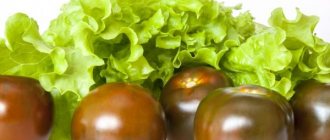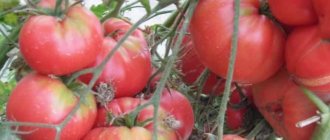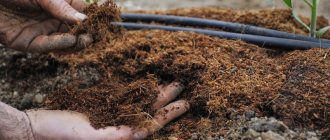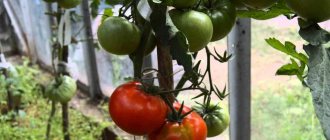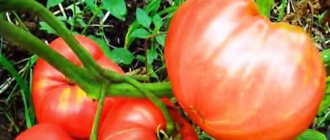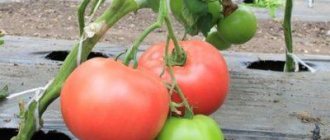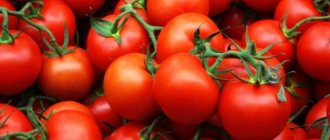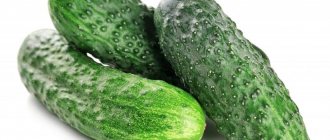The Great White tomato, which is usually translated as “White Giant,” is a unique white-fruited variety that any gardener will be happy to boast of. No one will have such tomatoes, and their taste will not be inferior to exotic types of tomatoes.
| Height | Landing location | Ripening time | Fruit color | Fruit size | Origin | Fruit shape |
| Tall | Greenhouse, Open ground | Mid-season | White | Large | Variety | Flat-round |
Description
The original name of the variety is “Great Write Blues”. Grows well in central Russia, Belarus, and Ukraine. Considered exotic.
The highest yields can be achieved by growing tomatoes in greenhouses. In open ground the yield is practically zero.
The fruits are suitable for fresh consumption. And also for making juices.
Description and characteristics of the variety
The variety was bred by American breeders in the 1980s.
Great White is a tall, indeterminate bush that can grow up to 2 meters in height. It is recommended to grow it in greenhouses. Mid-season, fruits ripen 110-130 days after seed germination. The tomatoes are large, weighing 300-500 g, but some gardeners receive 800 g.
The color is milky white. But there are two subspecies that have a different shade. Great White purple is a variety with milky flesh but purple or brown skin. Great White blues tomato - very similar to the previous one, it can be purple or brown, and the flesh is light, yellowish and juicy.
The tomatoes taste very sweet with barely noticeable sourness. They are used to prepare white tomato juice, sauces and pastes, for salads and to decorate dishes. You won’t be able to preserve it entirely, but you can include it in vegetable mixtures.
The pulp of white tomatoes is considered the lightest and most dietary, so it is suitable even for allergy sufferers.
Characteristic
- Tall. On average it grows up to 1.8 meters.
- The weight of each fruit is about 300 g.
- To obtain the highest yield, it should be formed into 1 or 2 stems.
Interesting
Amazing fact: fruits can ripen in different colors: yellow, brown, purple. This is influenced by various factors. They turn purple under the influence of low temperatures. Fruits of this color are considered rare. If you want to grow just like this, it is advisable to add additional light to the bushes. You can organize additional lighting at night, for example, in a greenhouse using electricity.
Characteristics of the Great White Blues tomato
The variety is a representative of exotic varieties on the tomato market in Russia and is interesting for growing in greenhouse conditions in central Russia.
Description of the variety Great White Blues:
- tall (up to 1.8m);
- indeterminate;
- mid-season;
- average yield;
- resistant to diseases;
- grown in a greenhouse.
Fruit characteristics:
- round, flattened on top;
- soft peach color;
- the hangers are dark purple;
- weight from 200 to 350 grams;
- fleshy;
- juicy;
- dense pulp;
- do not crack;
- used fresh for making juices.
The yellow or pale yellow color of tomatoes is not a very common color for this crop, and varieties with this fruit color have their own characteristics that distinguish them from other varieties.
Rules for growing seedlings
- Before sowing, it is advisable to keep the seeds in a pink solution of potassium permanganate for about 20 minutes. Those that float should be thrown away - they will not rise. The rest - sow. Before doing this, be sure to rinse in water.
- To disinfect the seeds, they can be left for 20 minutes in a glass of vodka.
- They will sprout faster if, on the eve of sowing, you put them in a warm place for 2-3 days and cover them with a damp cloth. It should be moisturized regularly.
Description of the tomato variety “GREAT WHITE”
If you are looking for a good variety of tomatoes that won’t grow on every neighbor in your dacha, then you’ve come to the right place. Here you will learn about the characteristics of the “GREAT WHITE” tomato and its cultivation. What does “Big White” or “White Giant” mean? The name was really given to the tomato for a reason.
Description of the variety and its characteristics
- The tomato belongs to varieties with medium ripening periods. In open ground you will get the first harvest in about 125 days, in a greenhouse 10-14 days earlier. Accordingly, tomatoes can be grown both outdoors and indoors.
- The color of tomatoes is light yellow or milky. The variety is considered one of the best among white-fruited ones.
- The bush grows powerful and can reach two meters in length. Therefore, it requires gartering and shaping. Stepchildren also need to be removed.
- The variety is demanding on moisture, but at the same time it is unpretentious and has resistance to diseases.
- It produces large fruits, which is why it got its name. Tomatoes can weigh up to a kilogram. Average weight 400-500 grams. Therefore, they cannot be preserved in their entire form.
- Very tasty and aromatic fruits that can be used for fresh food, sauces, and juices. The pulp is fleshy and juicy.
- High-yielding variety.
- During the ripening of the fruits, it is necessary to ensure that the tomatoes do not touch the ground and the bushes are not too thick, otherwise the harvest will spoil.
- The shelf life of the fruit is short.
The “GREAT WHITE” tomato, the variety description of which is presented above, is rarely seen in the garden beds of summer residents, so if you love everything unusual and new, then this variety is for you. It has a lot of advantages, and the only disadvantages are the need for formation, garter, and regular watering. But this is compensated by the high yield of large fruits.
Agrotechnics of cultivation
Seeds are planted in March, after preliminary disinfection in a manganese solution.
The seeds are not buried deeply in the soil; they are watered after planting with a spray bottle and covered with film. In the phase of two leaves, they are planted if they have not previously been sown in tablets or in separate pots. You can buy ready-made soil or make your own using sand, peat, humus and garden soil in approximately equal proportions. Then add a spoonful of ash. The transfer of seedlings to the street is carried out after the last frost; supports are made in advance. It is better not to plant bushes more often than three bushes per square meter or in a row. Mineral fertilizer is poured into the hole before planting. After which they add 2-3 more times during the season. You can also just throw in organic matter for feeding.
They form bushes with 1-2 stems. It was already said earlier in the description of the “GREAT WHITE” tomato variety that it is necessary to water the bushes regularly, after which the soil is loosened. If a tomato is grown in a greenhouse, then it is ventilated. When the fruits begin to ripen, supports will also be needed for the branches. It is better to remove excess leaves.
That's all the main techniques of agricultural technology. Nothing complicated, but the result is excellent. You will definitely like this variety.
Transplanting into a greenhouse or open ground
- When planting seedlings in the ground, its height, as a rule, reaches 30-35 cm.
- In the middle zone, the right time for this is the end of May-beginning of June. By this time, the threat of return frosts should have passed, and the soil should warm up to +10 degrees.
- The soil for planting must be prepared, ideally in the fall. It is good to add horse manure or complex mineral fertilizers (according to the instructions).
- Planted bushes should be immediately tied to supports.
- Once planted, you need to water it. The next watering and first fertilizing should be no earlier than a week later.
Transplanting seedlings into a greenhouse
Tips for transplantation:
- seedlings must be ready for transplanting: height 30-35cm, strong, leafy;
- the timing of transplantation depends on the climate of the region (seedlings are planted in a greenhouse without heating in the last days of May or in the first days of June);
- the soil in the greenhouse is treated with boiling water, copper sulfate, and Bordeaux mixture;
- the greenhouse must be treated with disinfectants in the fall or spring before planting;
- It is better to apply fertilizers to insufficiently nutritious greenhouse soil in the fall, you can sow green manure;
- for good growth and sufficient lighting, maintain the distance between bushes in the range of 60-70cm, planting in a checkerboard pattern;
- It is advisable to immediately tie the bushes to a support;
- plant bushes that are too tall at an angle;
Advice! It is better to transplant in the late afternoon and in cloudy weather.
- immediately after transplanting, water the plants, then do not water them for several days or a week, do not loosen the soil, do not feed them - this will help them get used to the new conditions better.
Care Tips
- It is important to regularly remove emerging stepsons.
- Ventilate the greenhouse for several hours every day.
- Treat against diseases and pests (despite the resistance of tomatoes to diseases, for greater reliability the procedure should be carried out 2-3 times per season).
- Water every day (preferably in the evening).
- When weeds appear, weed the beds.
- Be sure to feed every 10-12 days. Both organic and complex mineral fertilizers are suitable.
Features of yellow tomatoes
- hypoallergenic (can be used by people prone to allergies);
- suitable for nutrition in children and the elderly;
- taste qualities (sweet, juicy) are good for fresh consumption;
- lower acid content than in red tomatoes;
- contain antioxidants (large amount of lycopene in the composition);
- myocin in the composition is involved in the normalization of the heart and blood vessels.
Information! The purple color of the shoulders is given by the anthocyanin pigment (found in blackberries, blueberries, currants), which appears in bright light and low temperatures.
Reviews
Maria Viktorovna, Minsk region.
The tomato did not disappoint me. Pleasant fruit taste, not sour. Goes great with other vegetables in salads. I learned about this variety from my friend. She gave it to me to try. I was also surprised by the color. I will definitely plant it next year.
Leonid Leonidovich, Mogilev region.
Personally, my approach to this variety is this. I remove the stepsons almost every 3-4 days. When the first fruits appear, I quickly remove most of the leaves. I fertilize once every 2 weeks, while the leaves are growing, with organic matter, then only with mineral fertilizers. To prevent late blight, I spray it with an aqueous solution of serum (1 liter per 10 liters of water) 3 times during the growing season. Very tasty tomatoes! In salads - simply amazing!
Benefits of the Great White Blues Tomato
Great White Blues has advantages as an indeterminate variety and as a variety with fruit characteristics:
- high growth ensures a good harvest;
- the bush is illuminated and ventilated evenly while observing planting standards;
- simplified formation (all stepsons are removed - 1 trunk is formed, one stepson remains - two trunks);
- resistant to fungal diseases;
- bears fruit for a long time;
- the fruits are tasty, not sour;
- beautiful appearance of the fruit;
- the fruits do not crack.
Disadvantages of the variety:
- obligatory garter to trellises or vertical support;
- stepsoning;
- later onset of flowering and fruit ripening.
